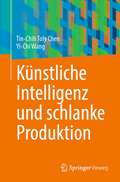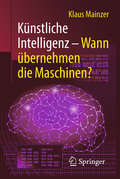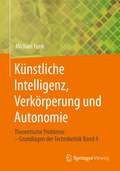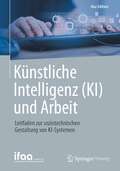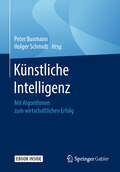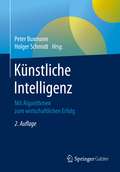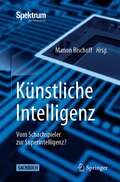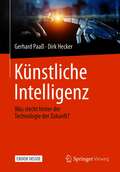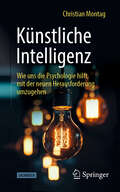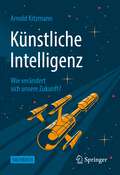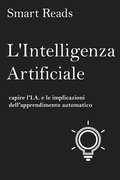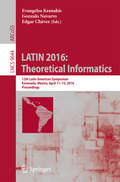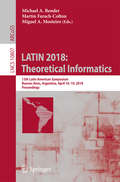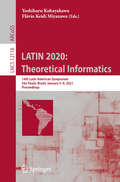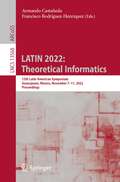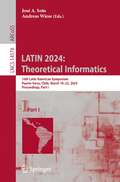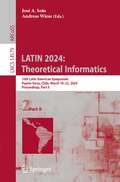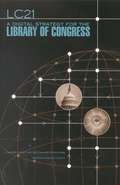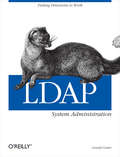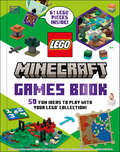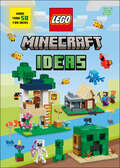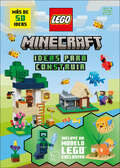- Table View
- List View
Künstliche Intelligenz und schlanke Produktion
by Tin-Chih Toly Chen Yi-Chi WangDieses Buch wendet künstliche Intelligenz auf die schlanke Produktion an und zeigt, wie sich die Vorteile dieser beiden Disziplinen praktisch kombinieren lassen. Die schlanke Produktion hat ihren Ursprung in Japan und ist ein bekanntes Instrument zur Verbesserung der Wettbewerbsfähigkeit der Hersteller. Zu den gängigen Werkzeugen der schlanken Produktion gehören Kanban, Pacemaker, Wertstromkarte, 5s, Just-in-Time und Pull Manufacturing. Lean Manufacturing und das Toyota-Produktionssystem wurden in verschiedenen Fabriken und Lieferketten auf der ganzen Welt erfolgreich eingesetzt. Ein schlankes Fertigungssystem kann nicht nur Verschwendung und Lagerbestände reduzieren, sondern auch unmittelbarer auf Kundenbedürfnisse reagieren. Künstliche Intelligenz ist ein Thema, das in letzter Zeit viel Aufmerksamkeit auf sich gezogen hat. Viele Forscher und praktische Entwickler arbeiten hart daran, künstliche Intelligenz in unserem täglichen Leben anzuwenden, auch in Fabriken. So wurden beispielsweise Fuzzy-Regeln zur Optimierung von Maschineneinstellungen entwickelt. Es wurden bionische Algorithmen vorgeschlagen, um Probleme bei der Produktionsreihenfolge und -planung zu lösen. Technologien des maschinellen Lernens werden eingesetzt, um mögliche Probleme mit der Produktqualität zu erkennen und den Zustand einer Maschine zu diagnostizieren. Dieses Buch ist für Produktionsingenieure, Manager sowie für Studenten und Forscher im Bereich der Fertigungstechnik von Interesse.
Künstliche Intelligenz – Wann übernehmen die Maschinen?
by Klaus MainzerJeder kennt sie. Smartphones, die mit uns sprechen, Armbanduhren, die unsere Gesundheitsdaten aufzeichnen, Arbeitsabläufe, die sich automatisch organisieren, Autos, Flugzeuge und Drohnen, die sich selber steuern, Verkehrs- und Energiesysteme mit autonomer Logistik oder Roboter, die ferne Planeten erkunden, sind technische Beispiele einer vernetzten Welt intelligenter Systeme. Machine Learning verändert unsere Zivilisation dramatisch. Wir verlassen uns immer mehr auf effiziente Algorithmen, weil die Komplexität unserer zivilisatorischen Infrastruktur sonst nicht zu bewältigen ist. Aber wie sicher sind KI-Algorithmen? Diese Herausforderung wird in der 2.Auflage aufgegriffen: Komplexe neuronale Netze werden mit riesigen Datenmengen (Big Data) gefüttert und trainiert. Die Anzahl der dazu notwenigen Parameter explodiert exponentiell. Niemand weiß genau, was sich in diesen „Black Boxes“ im Einzelnen abspielt. Im Machine Learning benötigen wir mehr Erklärung (explainability) und Zurechnung (accountability) von Ursachen und Wirkungen, um ethische und rechtliche Fragen der Verantwortung (z.B. beim autonomen Fahren oder in der Medizin) entscheiden zu können! Seit ihrer Entstehung ist die KI-Forschung mit großen Visionen über die Zukunft der Menschheit verbunden. Sie ist bereits eine Schlüsseltechnologie, die den globalen Wettstreit der Gesellschaftssysteme entscheiden wird. „Künstliche Intelligenz und Verantwortung“ ist eine weitere zentrale Ergänzung der 2. Auflage: Wie sollen wir unsere individuellen Freiheitsrechte in der KI-Welt sichern? Dieses Buch ist ein Plädoyer für Technikgestaltung: KI muss sich als Dienstleistung in der Gesellschaft bewähren.
Künstliche Intelligenz, Verkörperung und Autonomie: Theoretische Probleme – Grundlagen der Technikethik Band 4
by Michael FunkWas wissen Maschinen? Können sie wirklich mit uns sprechen? Haben sie Bewusstsein? Was ist gemeint, wenn Roboter als „verkörperte KI“ oder als „autonom“ bezeichnet werden? Vorliegendes Buch stellt sich diesen und weiteren Fragen. Denn Technikethik ist eng mit theoretischen Herausforderungen verbunden. Vor diesem Hintergrund wird in die Erkenntnislehre, Sprachanalyse, Körper-Geist-Verhältnisse sowie die Philosophie des Geistes systematisch eingeführt. Manches, das wir Maschinen vorschnell zuschreiben, entpuppt sich bei genauer Betrachtung als Schein. Warum ist das so? Mit Beispielen, Tabellen und Übersichten werden Antworten eingängig und strukturiert erarbeitet. Das Buch richtet sich an Ingenieurwissenschaftler*innen, Informatiker*innen und Geisteswissenschaftler*innen im Berufsalltag, aber auch an interessierte Lai*innen, die Möglichkeiten und Grenzen der KI kritisch hinterfragen wollen. Es bildet den vierten, in sich abgerundeten Teil der Buchreihe Grundlagen der Technikethik.Haben Maschinen den Geist, den wir brauchen, und brauchen wir den Geist, in dem wir Maschinen designen?
Künstliche Intelligenz: Das Psi-Organ in der Nussschale
by Dietmar DietrichDie Psyche mit dem neuronalen System verschmelzen zu können, ist ein lang angestrebtes Ziel. Wissenschaftler brauchen oft Jahre, um die Hürden auf dem Weg dahin zu begreifen. Ist das unumgänglich? Welche naturwissenschaftlichen Prinzipien liegen dem vorliegenden Modell zugrunde? Kann es ohne mathematischen Formalismus verstanden werden? Wie kann ein simuliertes Modell dieser Zusammenführung von Psyche und Neurologie – nennen wir es das Psi-Organ – aus heutiger Sicht aussehen?Mit Hilfe von Simulationsexperimenten können damit psychologische und soziale Theorien auf naturwissenschaftlicher Basis überprüft werden. Das Modell kann als Grundlage für KI-Systeme dienen, die Menschenleben retten, Energie sparen, für Sicherheit auf Flughäfen sorgen, bei der Pflege älterer Menschen unterstützen und vieles mehr. Dieses Psi-Organ-Modell geht weit über die heutigen, hauptsächlich verhaltensbasierten KI-Systeme hinaus.Das Manuskript ist als Einführung zum Verständnis und der Modellierung des menschlichen Geistes und der künstlichen, humanoiden "Intelligenz" zu verstehen.
Künstliche Intelligenz: Leitfaden zur soziotechnischen Gestaltung von KI-Systemen (ifaa-Edition)
by Sascha StowasserDies ist ein Handbuch für Unternehmen, Verbände und Beratungsgesellschaften, die die Potenziale von KI-Systemen in kleinen und mittleren Unternehmen erschließen wollen. Wie muss KI in Unternehmen eingeführt werden, um die Potenziale von KI gleichermaßen für Unternehmen und Beschäftigte zu nutzen? Im Buch geht es um die Frage, wie man KI-gestützte Arbeitssysteme so gestalten kann, dass sie den Anforderungen seitens der Technik, der Organisation und der Beschäftigten gerecht werden. Das Handbuch bietet praxisnahe Vorgehensweisen, die den aktuellen Stand der Wissenschaft mit Erfahrungen aus der betrieblichen Praxis verbinden. Der Leser erhält wertvolle Tipps und Strategien für die Zukunft der Arbeit. Ein Muss für alle, die die Chancen von KI nutzen wollen, ohne die Bedürfnisse der Beschäftigten zu vernachlässigen.
Künstliche Intelligenz: Mit Algorithmen zum wirtschaftlichen Erfolg
by Holger Schmidt Peter BuxmannDieses Buch soll dabei helfen, die neuen Technologien und Anwendungspotenziale der künstlichen Intelligenz besser zu verstehen und einzuordnen. Neben einer ausführlichen und verständlichen Vermittlung grundlegender Kenntnisse und ökonomischer Effekte der künstlichen Intelligenz enthält es viele Anwendungsbeispiele bekannter Unternehmen. Konzerne wie Amazon, IBM, Microsoft, SAP oder VW lassen die Leser in ihre KI-Labors schauen und erklären konkrete Projekte zu Themen, wie z. B. Chatbots, Quantencomputing, Gesichtserkennung, sprachbasierte Systeme oder den Einsatz von KI-Anwendungen in den Bereichen Marketing, Vertrieb, Finanzen, Personalwesen, Produktion, Gesundheit sowie Logistik. Das Buch richtet sich an Entscheider in Unternehmen, Studierende, Dozenten und alle, die sich ein Bild über die vielleicht wichtigste technologische Entwicklung in diesem Jahrhundert machen möchten.
Künstliche Intelligenz: Mit Algorithmen zum wirtschaftlichen Erfolg
by Holger Schmidt Peter BuxmannKünstliche Intelligenz (KI) und insbesondere Algorithmen zum Maschinellen Lernen verändern Wirtschaft und Gesellschaft wie keine andere Technologie. Dieses Buch zeigt Entscheidern in Unternehmen, aber auch allen anderen technologiebegeisterten Leserinnen und Lesern, wie KI heute konkret eingesetzt wird und welche ökonomischen Vorteile erzielt werden. Nach einer allgemein verständlichen Einführung in die technischen Grundlagen und die wirtschaftlichen Auswirkungen von KI bilden zehn Fallstudien den Kern des Buches. Darin stellen Digitalkonzerne ihre KI-Strategien vor und Unternehmen aus den Branchen Automobil, Chemie, Finanzen, Handel und Industrie erläutern, wie sie KI einsetzen. Abschließend wird komprimiert dargestellt, was Entscheidungsträger aus Wirtschaft und Politik sowie interessierte Bürgerinnen und Bürger über die aktuellen ethischen Debatten rund um das Thema KI heute wissen müssen.
Künstliche Intelligenz: Vom Schachspieler zur Superintelligenz?
by Manon BischoffKünstliche Intelligenz ist längst nicht mehr nur ein ernstzunehmender Schachgegner, sondern reicht in der Anwendung weit in unseren Alltag hinein. Doch was macht einen Computer eigentlich intelligent? Wie lernen Algorithmen und wie bringt man einer Maschine das Spielen bei? Wobei kann uns KI heute und in Zukunft helfen – und wo versagen die selbstlernenden Programme?Die hier zusammengestellten Artikel aus »Spektrum der Wissenschaft«, »Gehirn&Geist« und »spektrum.de« bieten eine themenübergreifende Übersicht zu den wichtigsten Fragen der künstlichen Intelligenz. Interessierte Laien ohne besonderes Vorwissen erhalten einen Überblick von den Grundlagen neuronaler Netze und evolutionärer Algorithmen bis hin zu aktuellen Forschungsfragen aus Naturwissenschaft und Technik.Im ersten Teil des Buchs erfahren Sie, wie man einem Computer beibringt, selbstständig zu lernen, mit welchen Tricks man Algorithmen weiter verbessert und bekannte Schwächen behebt – und wie sogar Maschinen kreativ werden können. Inwiefern das speziell beim Erlernen von Brett- und Videospielen passiert und was das für weitere Anwendungen bedeutet, erklären wir im zweiten Teil. Der dritte Abschnitt beschäftigt sich mit den Fortschritten in Forschung und Technik, die Wissenschaftler mit Hilfe von KI erlangen: von der Suche nach neuer Physik bis hin zu der Entwicklung neuer Medikamente. Das letzte Kapitel widmet sich der Frage, wo die Grenzen des vermeintlichen Alleskönners KI liegen – und welche potenziellen Gefahren heute und in Zukunft davon ausgehen.
Künstliche Intelligenz: Was steckt hinter der Technologie der Zukunft?
by Gerhard Paaß Dirk HeckerKünstliche Intelligenz (KI) ist heute schon in unserem Alltag präsent und wird uns zukünftig in nahezu allen Lebensbereichen begegnen – von der bildgestützten Diagnose in der Medizin über das autonome Fahren und die intelligente Maschinenwartung in der Industrie bis hin zur Sprachsteuerung im smarten Zuhause. Die Potenziale der KI sind enorm, gleichzeitig kursieren viele Mythen, Ungewissheiten und Herausforderungen, die es zu meistern gilt. Dieses Buch adressiert daher die breite Öffentlichkeit – von interessierten Bürgerinnen und Bürgern bis hin zur Leitungsebene in Unternehmen, die ein besseres und tieferes technisches Verständnis von KI-Technologien aufbauen und deren Folgen abschätzen möchten.In verständlicher Sprache werden mathematische Grundlagen, Begriffe und Methoden erläutert. Eine abschließende Diskussion der Chancen und Herausforderungen hilft den Leserinnen und Lesern, die Entwicklungen zu bewerten, sie zu entmystifizieren und ihre Relevanz für die Zukunft zu erkennen.
Künstliche Intelligenz: Wie uns die Psychologie hilft, mit der neuen Herausforderung umzugehen
by Christian MontagKünstliche Intelligenz (KI) ist spätestens seit der Einführung durch ChatGPT im November 2022 in aller Munde. Damit steht auch eine große Frage im Raum: Wie wird diese Technologie unser Leben und unsere Gesellschaft verändern? Zwischen Hype und Apokalypse gilt es eine nuancierte Haltung gegenüber der KI-Technologie zu entwickeln, wobei Risiken und Potentiale gleichermaßen abgewogen werden müssen. Dies ist nicht leicht, weil es sich bei der KI um eine Allzweck-Technologie handelt, die ähnlich der Elektrizität, in vielen Bereichen eine wesentliche Rolle spielen wird. Warum sollten Sie dieses Buch lesen? In einer Zeit, in der KI unser tägliches Leben immer mehr durchdringt, bietet dieses Buch nicht nur psychologisch fundierte Einsichten, sondern hilft Ihnen auch, selbstbewusster und informierter mit den Veränderungen umzugehen. Denn: um eine ausgewogene und zugleich fundierte Haltung gegenüber der KI zu entwickeln, bringt der Autor für Sie die wichtigsten psychologischen Erkenntnisse rund um das Thema KI in klarer, verständlicher Sprache und mit anschaulichen Abbildungen auf den Punkt. Ein kompaktes Sachbuch, das interessierten Lesern und Leserinnen hilft, die Herausforderungen und Chancen der KI besser zu verstehen.
Künstliche Intelligenz: Wie verändert sich unsere Zukunft?
by Arnold KitzmannKünstliche Intelligenz (KI) durchdringt zunehmend unser gesamtes Leben, angefangen bei den hochwillkommenen kleinen Erleichterungen des Alltags bis hin zu gravierenden gesellschaftlichen Veränderungen in Arbeitswelt, Forschung und Entwicklung sowie der Privatsphäre jedes Einzelnen. Wir können uns dieser Entwicklung nicht (mehr) entziehen oder gar verweigern, sondern sind gefordert, uns mit ihr auseinanderzusetzen. Dieses Buch erörtert philosophische, ethische, politische, ökonomische Aspekte ebenso wie die Problematik der Selbstbestimmtheit, Freiheit und Manipulierbarkeit des Einzelnen. So entsteht ein kleiner Leitfaden für den Leser, um sich selbst in dieser Phase großer gesellschaftlicher Umwälzungen zu positionieren. Last not least spannend: In der Auseinandersetzung mit Künstlicher Intelligenz wird klar, dass sie uns Heutigen mit Fragen konfrontiert, die bereits die Philosophie vor über zweieinhalb Jahrtausenden umtrieb.
L'Intelligenza Artificiale: capire l'I.A. e le implicazioni dell'apprendimento automatico
by Stefano Vazzola Smart ReadsElon Musk, Stephen Hawking e Bill Gates hanno affermato che l'Intelligenza Artificiale potrebbe costituire una minaccia in futuro a meno che gli umani non imparino a usarla saggiamente. Potrebbe essere vero? Potremo creare un programma di intelligenza artificiale che a breve disporrà di pensiero e sentimenti di IA? Potremo addirittura avere un'IA dall'aspetto umano che si candidi a presidente in futuro? Tutte queste domande e queste riflessioni vengono prese in esame in L'Intelligenza Artificiale: capire l'I.A. e le implicazioni dell'apprendimento automatico. È un libro studiato per offrire una panoramica concisa dei primordi delle macchine intelligenti, del nostro approccio moderno e del suo impatto sulla tecnologia del futuro e sull'esistenza umana.
LATIN 2016: Theoretical Informatics
by Gonzalo Navarro Evangelos Kranakis Edgar ChávezThis book constitutes therefereed proceedings of the 12th Latin American Symposium on TheoreticalInformatics, LATIN 2016, held in Ensenada, Mexico, in April 2016. The 52 papers presentedtogether with 5 abstracts were carefully reviewed and selected from 131submissions. The papers address a variety of topics in theoretical computerscience with a certain focus on algorithms (approximation, online,randomized, algorithmic game theory, etc. ), analytic combinatorics and analysisof algorithms, automata theory and formal languages, coding theory and datacompression, combinatorial algorithms, combinatorial optimization,combinatorics and graph theory, complexity theory, computational algebra,computational biology, computational geometry, computational number theory,cryptology, databases and information retrieval, data structures, formalmethods and security, Internet and the web, parallel and distributed computing,pattern matching, programming language theory, and random structures.
LATIN 2018: 13th Latin American Symposium, Buenos Aires, Argentina, April 16-19, 2018, Proceedings (Lecture Notes in Computer Science #10807)
by Miguel A. Mosteiro Michael A. Bender Martín Farach-ColtonThis book constitutes the proceedings of the 13th Latin American Symposium on Theoretical Informatics, LATIN 2018, held in Buenos Aires, Argentina, in April 2018. The 63 papers presented in this volume were carefully reviewed and selected from 161 submissions. The Symposium is devoted to different areas in theoretical computer science, including, but not limited to: algorithms (approximation, online, randomized, algorithmic game theory, etc.), analytic combinatorics and analysis of algorithms, automata theory and formal languages, coding theory and data compression, combinatorial algorithms, combinatorial optimization, combinatorics and graph theory, complexity theory, computational algebra, computational biology, computational geometry, computational number theory, cryptology, databases and information retrieval, data structures, formal methods and security, Internet and the web, parallel and distributed computing, pattern matching, programming language theory, and random structures.
LATIN 2020: 14th Latin American Symposium, São Paulo, Brazil, January 5-8, 2021, Proceedings (Lecture Notes in Computer Science #12118)
by Yoshiharu Kohayakawa Flávio Keidi MiyazawaThis book constitutes the refereed proceedings of the 14th Latin American Symposium on Theoretical Informatics, LATIN 2020, held in Sao Paulo, Brazil, in January 2021. The 50 full papers presented in this book were carefully reviewed and selected from 136 submissions. The papers are grouped into these topics: approximation algorithms; parameterized algorithms; algorithms and data structures; computational geometry; complexity theory; quantum computing; neural networks and biologically inspired computing; randomization; combinatorics; analytic and enumerative combinatorics; graph theory.Due to the Corona pandemic the event was postponed from May 2020 to January 2021.
LATIN 2022: 15th Latin American Symposium, Guanajuato, Mexico, November 7–11, 2022, Proceedings (Lecture Notes in Computer Science #13568)
by Francisco Rodríguez-Henríquez Armando CastañedaThis book constitutes the proceedings of the 15th Latin American Symposium on Theoretical Informatics, LATIN 2022, which took place in Guanajuato, Mexico, in November 2022. The 46 papers presented in this volume were carefully reviewed and selected from 114 submissions. They were organized in topical sections as follows: Algorithms and Data Structures; Approximation Algorithms; Cryptography; Social Choice Theory; Theoretical Machine Learning; Automata Theory and Formal Languages; Combinatorics and Graph Theory; Complexity Theory; Computational Geometry.Chapter “Klee’s Measure Problem Made Oblivious” is available open access under a CC BY 4.0 license.
LATIN 2024: 16th Latin American Symposium, Puerto Varas, Chile, March 18–22, 2024, Proceedings, Part I (Lecture Notes in Computer Science #14578)
by Andreas Wiese José A. SotoThis book constitutes the proceedings of the 16th Latin American Symposium on Theoretical Informatics, LATIN 2042, which took place in Puerto Varas, Chile, in March 2024. The 44 papers presented in this volume were carefully reviewed and selected from 93 submissions. They were organized in topical sections as follows:Part I: Algorithms and Data Structures; Approximation and Online Algorithms; Complexity Theory; Part II: Combinatorics and Graph Theory; Parameterized Algorithms; Automata Theory and Formal Languages; and Game Theory and Fairness.
LATIN 2024: 16th Latin American Symposium, Puerto Varas, Chile, March 18–22, 2024, Proceedings, Part II (Lecture Notes in Computer Science #14579)
by Andreas Wiese José A. SotoThis book constitutes the proceedings of the 16th Latin American Symposium on Theoretical Informatics, LATIN 2042, which took place in Puerto Varas, Chile, in March 2024. The 44 papers presented in this volume were carefully reviewed and selected from 93 submissions. They were organized in topical sections as follows:Part I: Algorithms and Data Structures; Approximation and Online Algorithms; Complexity Theory; Part II: Combinatorics and Graph Theory; Parameterized Algorithms; Automata Theory and Formal Languages; and Game Theory and Fairness.
LC21: A Digital Strategy for the Library of Congress
by National Research CouncilDigital information and networks challenge the core practices of libraries, archives, and all organizations with intensive information management needs in many respects-not only in terms of accommodating digital information and technology, but also through the need to develop new economic and organizational models for managing information. LC21: A Digital Strategy for the Library of Congress discusses these challenges and provides recommendations for moving forward at the Library of Congress, the world's largest library. Topics covered in LC21 include digital collections, digital preservation, digital cataloging (metadata), strategic planning, human resources, and general management and budgetary issues. The book identifies and elaborates upon a clear theme for the Library of Congress that is applicable more generally: the digital age calls for much more collaboration and cooperation than in the past. LC21 demonstrates that information-intensive organizations will have to change in fundamental ways to survive and prosper in the digital age.
LDAP System Administration
by Gerald CarterWith the potential to consolidate existing network services into a single directory, Lightweight Directory Access Protocol (LDAP) is exactly what overburdened system administrators have been waiting for. But LDAP can also be a headache for those trying to master the technology. LDAP System Administration takes a hands-on approach, providing system administrators with the tools they need to understand and implement LDAP. Author Jerry Carter talks about using directories for Unix system administration-specifically, the OpenLDAP directory-but the skills he teaches are also applicable to LDAP products from Microsoft, Sun, and Novell. His book tells readers how to get the directory running, how to get data into the directory, how to use a directory to replace local username and password lookups, and many other critical LDAP skills.
LDAP System Administration: Putting Directories to Work
by Gerald CarterBe more productive and make your life easier. That's what LDAP System Administration is all about.System administrators often spend a great deal of time managing configuration information located on many different machines: usernames, passwords, printer configurations, email client configurations, and network filesystem configurations, to name a few. LDAPv3 provides tools for centralizing all of the configuration information and placing it under your control. Rather than maintaining several administrative databases (NIS, Active Directory, Samba, and NFS configuration files), you can make changes in only one place and have all your systems immediately "see" the updated information.Practically platform independent, this book uses the widely available, open source OpenLDAP 2 directory server as a premise for examples, showing you how to use it to help you manage your configuration information effectively and securely. OpenLDAP 2 ships with most Linux® distributions and Mac OS® X, and can be easily downloaded for most Unix-based systems. After introducing the workings of a directory service and the LDAP protocol, all aspects of building and installing OpenLDAP, plus key ancillary packages like SASL and OpenSSL, this book discusses:Configuration and access controlDistributed directories; replication and referralUsing OpenLDAP to replace NISUsing OpenLDAP to manage email configurationsUsing LDAP for abstraction with FTP and HTTP servers, Samba, and RadiusInteroperating with different LDAP servers, including Active DirectoryProgramming using Net::LDAPIf you want to be a master of your domain, LDAP System Administration will help you get up and running quickly regardless of which LDAP version you use. After reading this book, even with no previous LDAP experience, you'll be able to integrate a directory server into essential network services such as mail, DNS, HTTP, and SMB/CIFS.
LDPC Code Designs, Constructions, and Unification
by William E. Ryan Shu Lin Juane Li Khaled Abdel-Ghaffar Daniel J. CostelloWritten by leading experts, this self-contained text provides systematic coverage of LDPC codes and their construction techniques, unifying both algebraic- and graph-based approaches into a single theoretical framework (the superposition construction). An algebraic method for constructing protograph LDPC codes is described, and entirely new codes and techniques are presented. These include a new class of LDPC codes with doubly quasi-cyclic structure, as well as algebraic methods for constructing spatially and globally coupled LDPC codes. Authoritative, yet written using accessible language, this text is essential reading for electrical engineers, computer scientists and mathematicians working in communications and information theory.
LEGO Minecraft Games Book: 50 Fun Ideas to Play with Your LEGO Collection!
by Julia MarchThis edition does not include LEGO elements.Keep the whole family entertained with 50 ideas for LEGO® Minecraft® themed games, puzzles, and challenges!Challenge friends to a Nether minecart race. Find the odd crafting block out. Design your own LEGO Minecraft fairground. And much more!Get ready to level up the fun with your friends and family:ALL-NEW GAME IDEAS: Explore 50 brand-new LEGO Minecraft models and ideas for games, challenges, and puzzles – perfect for playing with family, friends, or on your ownSOMETHING FOR EVERYONE: The activities and games are great for all ages, making this the perfect gift for young LEGO builders and avid Minecraft fans alikeBuild in some time for bite-sized family fun with the LEGO Minecraft Games Book, packed with hours’ worth of ideas for LEGO Minecraft games, puzzles, and challenges. Also included are 61 Minecraft themed LEGO elements to add to your own collection and use alongside the games in the book, making this the ultimate experience for fun-loving LEGO Minecraft enthusiasts.©2025 The LEGO Group.©2025 Mojang AB.
LEGO Minecraft Ideas (Lego Ideas)
by Julia March Shari LastLevel up your LEGO® Minecraft® models with more than 50 building ideas!Use your LEGO collection to bring your Minecraft builds to life. Inspire budding builders to design a diamond sword, build a busy biome, make a micro mob, create a creeper house, and much more. Challenge family and friends to exciting games that combine the best bits of Minecraft and LEGO building.© 2024 Mojang AB ©2024 The LEGO Group.
LEGO Minecraft Ideas para construir: Incluye un modelo LEGO Exclusivo
by Julia March¡Pasa al siguiente nivel y lleva a cabo tus construcciones LEGO® Minecraft como un experto con más de 50 ideas de construcción!Level up your LEGO Minecraft builds with more than 50 byte-size building ideas!¡Pasa al siguiente nivel y lleva a cabo tus construcciones LEGO® Minecraft como un experto con más de 50 ideas de construcción!¡LEGO® y Minecraft son la combinación perfecta para futuros constructores, creadores e inventores! Este libro te muestra cómo utilizar tu colección de ladrillos LEGO® para darle vida a tus construcciones favoritas de Minecraft.Inspírate para diseñar una guarida, crear un castillo o hacer una casa en el árbol con más de 50 ideas increíbles. Desafía a familiares y amigos a emocionantes juegos que combinan lo mejor de Minecraft y la construcción con LEGO®.©2025 Mojang AB.©2025 The LEGO Group.------------------------------------------------------------------------------------Level up your LEGO Minecraft builds with more than 50 byte-size building ideas!LEGO and Minecraft are the perfect match for budding builders, creators, and inventors. This book shows readers how to use their LEGO brick collection to bring their Minecraft builds to life. Be inspired to design a den, create a castle, make a treehouse, and much more with over 50 amazing ideas. Challenge family and friends to exciting games that combine the best bits of Minecraft and LEGO building.© 2023 Mojang AB.©2023 The LEGO Group.
